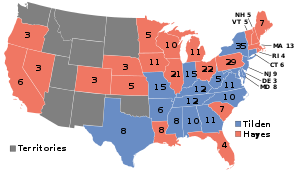Contested Election of 1876
Rutherford B. Hayes Vs. Samuel Tilden
During The 2020 Election, Many People Are Asking What Avenues Trump May Have To Win The Presidency.  For that reason I have gathered this bit of information from Wikipedia.
For that reason I have gathered this bit of information from Wikipedia.
Rutherford B. Hayes success in Ohio immediately elevated him to the top ranks of Republican politicians under consideration for the presidency in 1876. The Ohio delegation to the 1876 Republican National Convention was united behind him. The convention selected Representative William A. Wheeler from New York for vice president.
The Democratic nominee was Samuel J. Tilden, the governor of New York. Tilden was considered a formidable adversary who, like Hayes, had a reputation for honesty. Like Hayes, Tilden was a hard-money man and supported civil service reform.
The poor economic conditions made the party in power unpopular and made Hayes suspect he would lose the election. Both candidates concentrated on the swing states of New York and Indiana, as well as the three southern states—Louisiana, South Carolina, and Florida—where Reconstruction Republican governments still barely ruled, amid recurring political violence, including widespread efforts to suppress freedman voting. The Republicans emphasized the danger of letting Democrats run the nation so soon after southern Democrats had provoked the Civil War and, to a lesser extent, the danger a Democratic administration would pose to the recently won civil rights of southern blacks.
As the returns were tallied on election day, it was clear that the race was close: Democrats had carried most of the South, as well as New York, Indiana, Connecticut, and New Jersey. In the Northeast, an increasing number of immigrants and their descendants voted Democratic. Although Tilden won the popular vote and claimed 184 electoral votes, Republican leaders challenged the results and charged Democrats with fraud and voter suppression of blacks (who would otherwise have voted Republican) in Florida, Louisiana, and South Carolina.
Republicans realized that if they held the three disputed unredeemed southern states together with some of the western states, they would emerge with an electoral college majority.
Disputed electoral votes
On November 11, three days after election day, Tilden appeared to have won 184 electoral votes, one short of a majority. Hayes appeared to have 166, with the 19 votes of Florida, Louisiana, and South Carolina still in doubt. Republicans and Democrats each claimed victory in the three latter states, but the results in those states were rendered uncertain because of fraud by both parties. To further complicate matters, one of the three electors from Oregon (a state Hayes had won) was disqualified, reducing Hayes’s total to 165, and raising the disputed votes to 20. If Hayes was not awarded all 20 disputed votes, Tilden would be elected president.

Results of the 1876 election,
with states won by Hayes in RED,
and those won by Tilden in BLUE
There was considerable debate about which person or house of Congress was authorized to decide between the competing slates of electors, with the Republican Senate and the Democratic House each claiming priority. By January 1877, with the question still unresolved, Congress and President Grant agreed to submit the matter to a bipartisan Electoral Commission, which would be authorized to determine the fate of the disputed electoral votes. The Commission was to be made up of five representatives, five senators, and five Supreme Court justices. To ensure partisan balance, there would be seven Democrats and seven Republicans, with Justice David Davis, an independent respected by both parties, as the 15th member. The balance was upset when Democrats in the Illinois legislature elected Davis to the Senate, hoping to sway his vote. Davis disappointed Democrats by refusing to serve on the Commission because of his election to the Senate. As all the remaining Justices were Republicans, Justice Joseph P. Bradley, believed to be the most independent-minded of them, was selected to take Davis’s place on the Commission. The Commission met in February and the eight Republicans voted to award all 20 electoral votes to Hayes. Democrats, outraged by the result, attempted a filibuster to prevent Congress from accepting the Commission’s findings.
As inauguration day neared, Republican and Democratic Congressional leaders met at Wormley’s Hotel in Washington to negotiate a compromise. Republicans promised concessions in exchange for Democratic acquiescence to the Committee’s decision. The main concession Hayes promised was the withdrawal of federal troops from the South and an acceptance of the election of Democratic governments in the remaining “unredeemed” southern states. The Democrats agreed, and on March 2, the filibuster was ended. Hayes was elected, but Reconstruction was finished, and freedmen were left at the mercy of white Democrats who did not intend to preserve their rights.